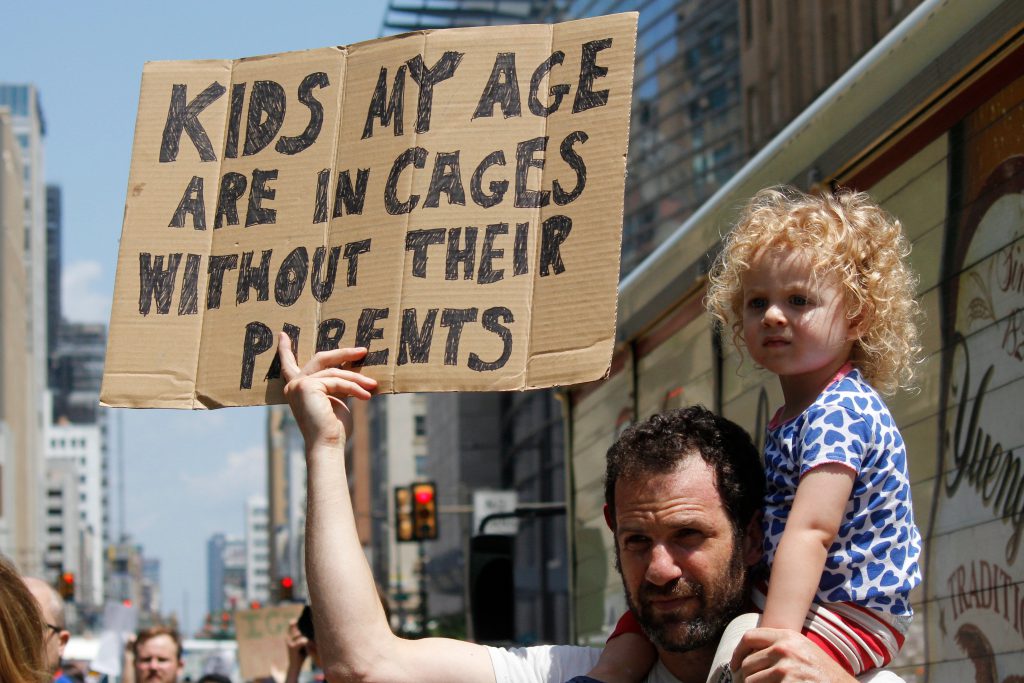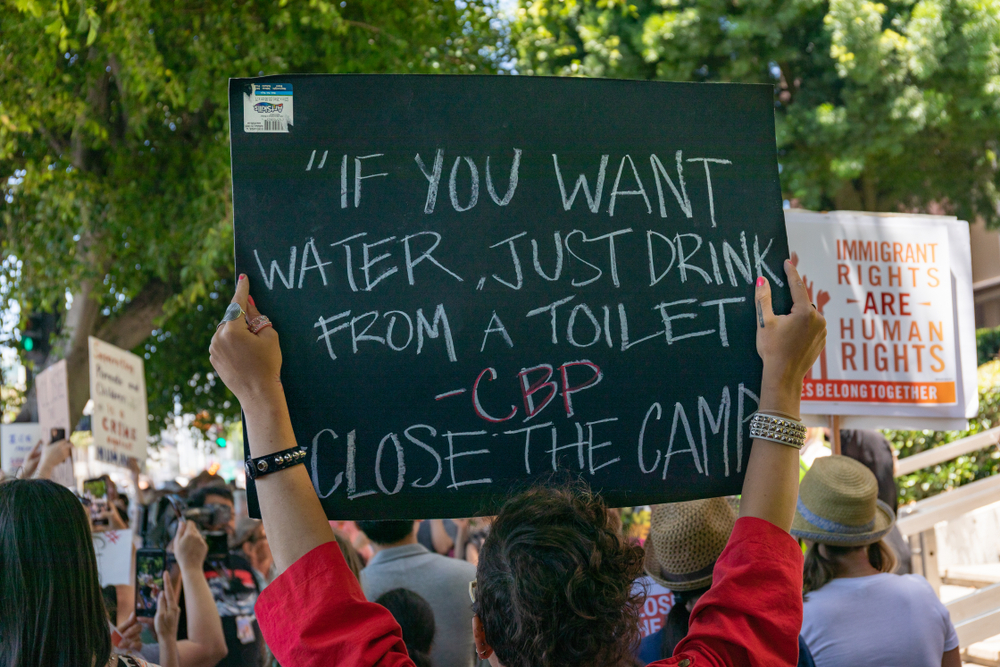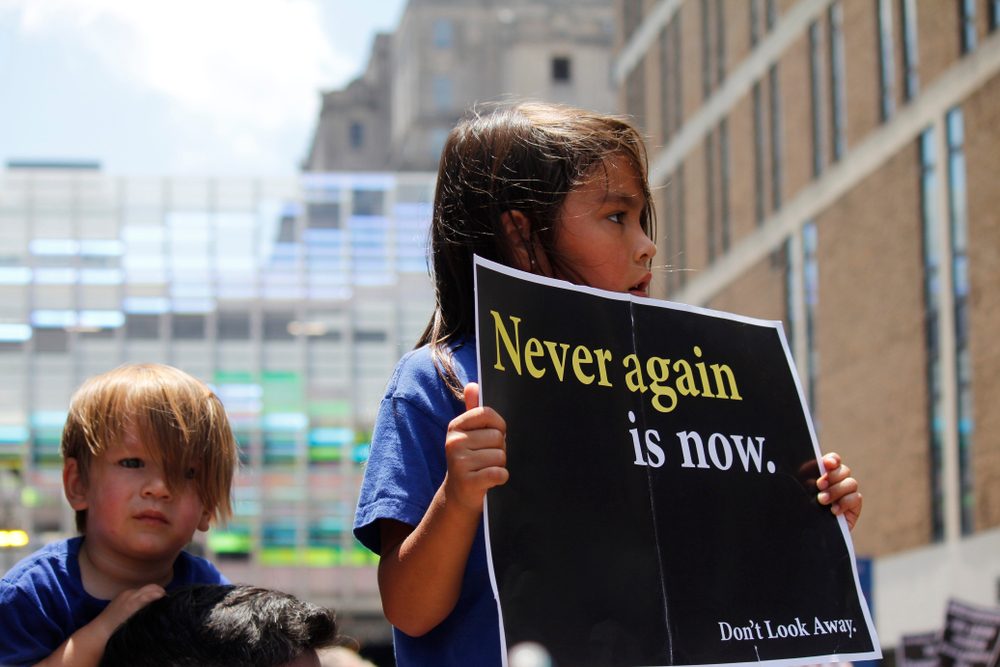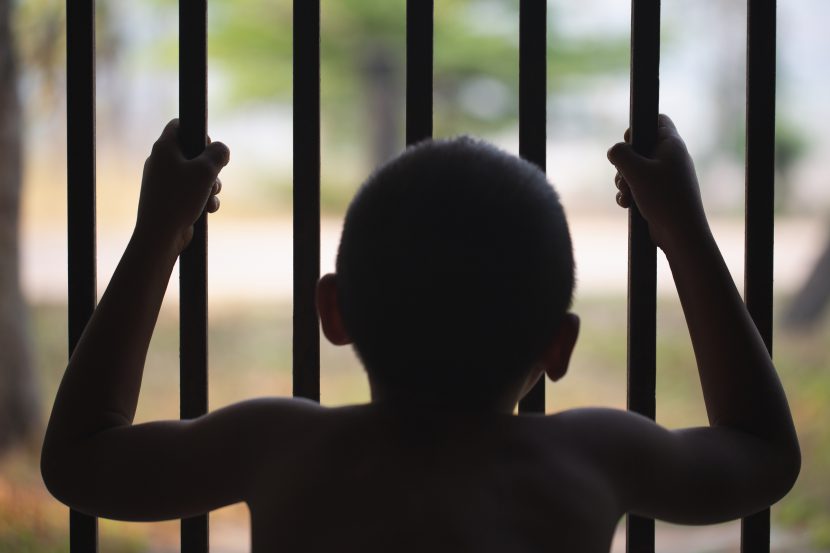The immeasurable detriment of child immigration detention continues to mount in prevalence. This article explores where and how the detention of children is taking place, in flagrant violation of international law and standards and in heartbreaking degradation to the wellbeing and safety of the innumerous minors it concerns.
A brief international media spotlight has passed over child detention facilities principally in the United States of America (USA), illuminating the heinous conditions children are made to endure. The article thus focuses on the USA and its counterpart in this matter: Australia, although there are nonetheless many other countries whose detention practices merit significant attention and scrutiny. Addressing child detention, however, must not lose sight of the initial inhumanity of immigration detention’s fundamental principle; the criminalisation of human movement as a premise for detention.
The United States of America’s debasement of minors
The dangerous and degrading conditions of the inhumane child for-profit detention centres in the United States of America have become an emergency. Almost 20,000 unaccompanied children have been apprehended this spring 2019 by US border control officials, notwithstanding the number of accompanied children taken into detention (Al Jazeera, 2019). Many of these children have family in the country desperately awaiting them with no news. Global Detention Project statistics show the number of detained unaccompanied minors in the USA supersedes the country’s entire detention capacity (Global Detention Project, 2019).
Boy, age 5
“I was apprehended with my father. The immigration agents separated me from my father right away. I was very frightened and scared. I cried. I have not seen my father again… I have had a cold and cough for several days. I have not seen a doctor and I have not been given any medicine.” (Rolling Stone, 2019)

In June 2019 a team of lawyers and doctors who visited the southern USA facilities and interviewed children reported to media outlets the abysmal conditions under which minors are detained. They also revealed the extensive periods of time children are made to endure this detention. Jail-like facilities fail to provide children with quotidien necessities for their health, safety and wellbeing; toothbrushes, clothes, soap, proper beds, blankets and regular access to showers and family visitation are all denied the imprisoned children who are as young as five months old and include pregnant and breastfeeding teenage mothers (Human Rights Watch, 2019). Many children sleep on concrete floors under foil blankets and eat the same innutritious meal every day which contains no fruit, vegetable or milk. Although US law should limit detention of children to a maximum of 72 hours, children were commonly found to have been in the facilities for weeks on end with no access to basic medical care or sanitation (Human Rights Watch, 2019). They were exposed to extreme cold, lights on 24 hours a day and regularly not provided with sufficient food or water, with many of the children reporting waking up throughout the night from hunger pains. Almost all conditions were severely overcrowded.
Seven children have died in US federal immigration custody or shortly after being released this year so far, compared to no such deaths in the 10 previous years combined (ACLU, 2019). Those who visited the detention centres feared that more children’s lives may be lost unless the situation is drastically improved.
Girl, age 17
“I was given a blanket and a mattress, but then, at 3 a.m., the guards took the blanket and mattress. My baby was left sleeping on the floor. In fact, almost every night, the guards wake us at 3 a.m. and take away our sleeping mattresses and blankets. They leave babies, even little babies of two or three months, sleeping on the cold floor. For me, because I am so pregnant, sleeping on the floor is very painful for my back and hips. I think the guards act this way to punish us.” (Rolling Stone, 2019)
Many of the children interviewed were wearing clothes stained with bodily fluids including mucus, breastmilk and urine (Human Rights Watch, 2019). Failure to provide interpreters or to keep medical records has been reported. Staff sexually abusing children has been reported. Child self harm has been reported. Many children cried in their interviews and some were unable to speak. In a medical declaration obtained exclusively by ABC Action News, the physician, Dolly Lucio Sevier wrote: “The conditions within which [the children] are held could be compared to torture facilities” (ABC, 2019).
Detention Context

Immigrant detention finds itself within a context of neocolonialism. Human movement from countries historically colonised, exploited and abused by western nations is now criminalised, privatised, securitised and made into a for-profit commodity, whilst human movement emanating from the west remains encouraged.
The militarisation and privatisation of the movement of forcibly displaced people sees governments increasingly outsourcing their border control and security to private entities. This is the case in the USA as well as in Europe where ‘externalisation’ border policies attempt to prevent people from ever arriving at European shores and thus from being able to access their legal status as refugees and ensuing rights on the continent.
The US for-profit companies such as Geo Group and non-profit companies like Southwest Key (last year’s budget was almost half a billion dollars) who run the current USA child detention business make up to $775 per child per day, which is paid by the US state (GQ, 2019). A policy of incarceration of forcibly displaced children is thus a wilful political decision. Most facilities in Europe are also run by private companies, as is the anti-immigration militarisation of European borders which pushes children into dangerous sea crossings, smuggling and trafficking rings without being left safe legal alternatives. Furthermore, the near entirety of detained children are black and brown children from the Global South.
The politically steeped contexts within which imprisoned children find themselves embroiled are thus racist as well as xenophobic, neoliberal as well as anti-immigrant and profiteering.
What can we do as individuals?
START LOCAL:
- Contact your local political representative, asking that they make diplomatic representations on your behalf to your Foreign Office/ Foreign Secretary to make it clear to their state partners in the international community (e.g. USA / Australia) as well as within your own country, that the immigration detention of children is unacceptable;
- Make direct complaints to the companies who own child detention centres;
- Become a foster carer and accommodate unaccompanied refugee children;
GIVE RESOURCES:
- Pay the bail of a child to get them out of immigration detention (see Guardian 2019);
- Give money to local and community organisations which provide social support and much needed services for detained immigrant children including working for the improvement of their conditions, and their ultimate release;
- Give your time to campaigning or
advocating on behalf of detained children;
- (Remember – Humanium started as a simple website on child rights information, or the charity Help4Refugees was born from one online fundraising campaign);
VOTE:
- Use your local and national (and possibly European) voting power to elect candidates and governments with a humane politic who will not implement harsh anti-immigration policies.
Written by Adrian Lakrichi and Josie Thum

Further Reading
- Australian Human Rights Commission, ‘4 An overview of the children in detention’ (2014), Retrieved from: https://www.humanrights.gov.au/our-work/4-overview-children-detention, accessed 24 July 2019.
- Global Detention Project, ‘Immigration Detention: “Never in the best interests of children”’ (2019), Retrieved from: https://www.globaldetentionproject.org/immigration-detention-never-best-interests-children, accessed 24 July 2019.
- Human Rights Watch, ‘We went to a US border detention centre for children and what we saw was awful’ (24 June 2019), Retrieved from: https://www.hrw.org/news/2019/06/24/we-went-us-border-detention-center-children-what-we-saw-was-awful, accessed on 24 July 2019.
- World Vision, ‘As last kids leave Nauru, World Vision calls on MPs to back new law for sick refugees detained offshore’(3 February 2019), Retrieved from: https://www.worldvision.com.au/media-centre/resource/as-last-kids-leave-nauru-world-vision-calls-on-mps-to-back-new-law-for-sick-refugees-detained-offshore, accessed 24 July 2019.
Bibliography
- ABC Action News, ‘Doctor compares conditions at immigration holding centres to ‘torture facilities’’ (24 June 2019), Retrieved from: https://www.abcactionnews.com/news/national/doctor-compares-conditions-for-children-at-immigrant-holding-centers-to-torture-facilities, accessed on 24 July 2019.
- ACLU, ‘Immigrant kids keep dying in CBP detention centres, and the DHS won’t take accountability’ (24 June 2019), Retrieved from: https://www.aclu.org/blog/immigrants-rights/immigrants-rights-and-detention/immigrant-kids-keep-dying-cbp-detention, accessed on 24 July 2019.
- Al Jazeera, ‘The fate of children who cross the US – Mexico border alone’, Podcast (7 June 2019), Retrieved from: https://www.aljazeera.com/podcasts/thetake/2019/06/fate-children-cross-mexico-border-190607151946636.html, accessed on 24 July 2019.
- Al Jazeera, ‘US relocates hundreds of migrant children from border facility’ (25 June 2019), Retrieved from: https://www.aljazeera.com/news/2019/06/relocates-hundreds-migrant-children-border-facility-190625020427101.html, accessed on 24 July 2019.
- Al Jazeera, ‘Australia offshore refugees’ (14 Jun 2019), Retrived from: https://www.aljazeera.com/podcasts/thetake/2019/06/australia-offshore-refugees-190614151225050.html, accessed 25/07/2019
- Al Jazeera, ‘Australia set repeal medical care bill for offshore refugees’ (4 Jul 2019), Retrieved from: https://www.aljazeera.com/news/2019/07/australia-set-repeal-medical-care-bill-offshore-refugees-190703080344628.html accessed on 24 July 2019.
- AP News, ‘US gov’t moves migrant kids after AP exposes bad treatment’ (25 June 2019), Retrieved from: https://apnews.com/a7a9acc4c6a546829a258e008d10d705?utm_source=Twitter&utm_campaign=SocialFlow&utm_medium=AP, accessed 24 July 2019.
- Atlantic, ‘Children were dirty, they were scared, and they were hungry’ (25 June 2019), Retrieved from: https://www.theatlantic.com/family/archive/2019/06/child-detention-centers-immigration-attorney-interview/592540/, accessed 24 July 2019.
- Australian Government, Department of Home Affairs, ‘Immigration Detention and Community Statistics Summary’ (31 January 2018), Retrieved from: https://www.homeaffairs.gov.au/research-and-stats/files/immigration-detention-statistics-31-january-2018.pdf, accessed 24 July 2019.
- Australian Human Rights Commission (HRC), ‘4 An overview of the children in detention’ (2019), Retrieved from: https://www.humanrights.gov.au/our-work/4-overview-children-detention, accessed 24 July 2019.
- AZ Mirror, ‘Six inspectors visited six Southwest Key facilities. Here’s what they found’ (16 May 2019), Retrieved from: https://www.azmirror.com/2019/05/16/state-inspectors-visited-six-southwest-key-facilities-heres-what-they-found/, accessed on 24 July 2019.
- BBC News, ‘Nauru migrants: Last four children to leave island for US’ (3 February 2019), Retrieved from: https://www.bbc.co.uk/news/world-australia-47107179, accessed 24 July 2019.
- BBC News, ‘Nauru refugees: The island where children have given up on life’ (1 september 2018), Retrieved from: https://www.bbc.co.uk/news/world-asia-45327058, accessed 24 July 2019.
- CNN World, ‘Children on Nauru in desperate need of help, activists tell Australia’ (20 August 2018), Retrieved from: https://edition-m.cnn.com/2018/08/20/australia/nauru-children-australia-intl/index.html, accessed 24 July 2019.
- End Children Detention, ‘The international human rights community affirms that immigration detention is a violation of the rights of children’ (2019), Retrieved from: https://endchilddetention.org/toolbox/issue-child-immigration-detention/international-law/child-rights/, accessed 24 July 2019.
- Global Detention Project, ‘Australia Immigration Detention’ (2019), Retrieved from: https://www.globaldetentionproject.org/countries/asia-pacific/australia, accessed 24 July 2019.
- Global Detention Project, ‘United States Profile’ (2019), Retrieved from: https://www.globaldetentionproject.org/countries/americas/united-states, accessed 24 July 2019.
- Global Detention Project, ‘Immigration Detention: “Never in the best interests of children”’ (2019), Retrieved from: https://www.globaldetentionproject.org/immigration-detention-never-best-interests-children, accessed 24 July 2019.
- Guardian, ‘Australia’s Loss is America’s Gain’: the Naru and Manus refugees starting anew in the US (29 January 2019), Retrieved from: https://www.theguardian.com/commentisfree/2019/jan/29/what-happened-to-the-deal-and-the-refugees-surviving-australian-and-us-politics, accessed 28 July 2019.
- Guardian, ‘It’s great to get kids off Nauru, but detention centres in Australia are like prisons’ (31 Octobre 2018), Retrieved from: https://www.theguardian.com/commentisfree/2018/nov/01/i-have-visited-detention-centres-in-australia-they-are-not-much-better-than-nauru, accessed 24 July 2019.
- Guardian, ‘This is an emergency: the volunteers bailing out migrants from detention’ (21 July 2019), Retrieved from: https://www.theguardian.com/us-news/2019/jul/20/us-migrants-bail-volunteers-emergency-immigration, accessed on 24 July 2019.
- GQ, ‘Trump’s child detention camps cost $775 per person every day’ (25 June 2019), Retrieved from: https://www.gq.com/story/trump-detention-camps-cost, accessed 24 July 2019.
- Human Rights Watch, ‘How to Help Children Detained at the US Border’ (26 June 2019), Retrieved from: https://www.hrw.org/news/2019/06/26/how-help-children-detained-us-border, accessed on 24 July 2019.
- Human Rights Watch, ‘We went to a US border detention centre for children and what we saw was awful’ (24 June 2019), Retrieved from:https://www.hrw.org/news/2019/06/24/we-went-us-border-detention-center-children-what-we-saw-was-awful, accessed on 24 July 2019.
- Marketplace, ‘The facilities that are housing children separated from their parents’ (20 June 2018), Retrieved from: https://www.marketplace.org/2018/06/20/southwest-key-nonprofit-detention-center/, accessed 24 July 2019.
- New York Times, ‘He’s built an empire, with detained migrant children as the bricks’ (2 December 2018), Retrieved from: https://www.nytimes.com/2018/12/02/us/southwest-key-migrant-children.html, accessed 24 July 2019.
- NBC News, ‘24 migrants have died in ICE custody during the Trump administration’ (9 June 2019), Retrieved from: https://www.nbcnews.com/politics/immigration/24-immigrants-have-died-ice-custody-during-trump-administration-n1015291, accessed on 24 July 2019.
- Pacific Standard, ‘Can we be sure only six migrant children have recently died in government custody?’ (23 May 2019), Retrieved from: https://psmag.com/news/can-we-be-sure-only-six-migrant-children-have-recently-died-in-government-custody, accessed on 24 July 2019.
- Rolling Stone, ‘Children inside texas detention centres describe squalid conditions’ (27 June 2019), Retrieved from: https://www.rollingstone.com/politics/politics-news/texas-border-children-parent-separation-migrant-detention-centers-853055/, accessed on 24 July 2019.
- UN Committee on the Rights of the Child (CRC), ‘Committee on the Rights of the Child, Report of the 2012 Day of General Discussion on the Rights of All Children in the Context of International Migration’ (28 September 2012), Retrieved from: https://www.refworld.org/docid/51efb6fa4.html, accessed 24 July 2019.
- World Vision, ‘As last kids leave Nauru, World Vision calls on MPs to back new law for sick refugees detained offshore’ (3 February 2019), Retrieved from: https://www.worldvision.com.au/media-centre/resource/as-last-kids-leave-nauru-world-vision-calls-on-mps-to-back-new-law-for-sick-refugees-detained-offshore, accessed 24 July 2019.


